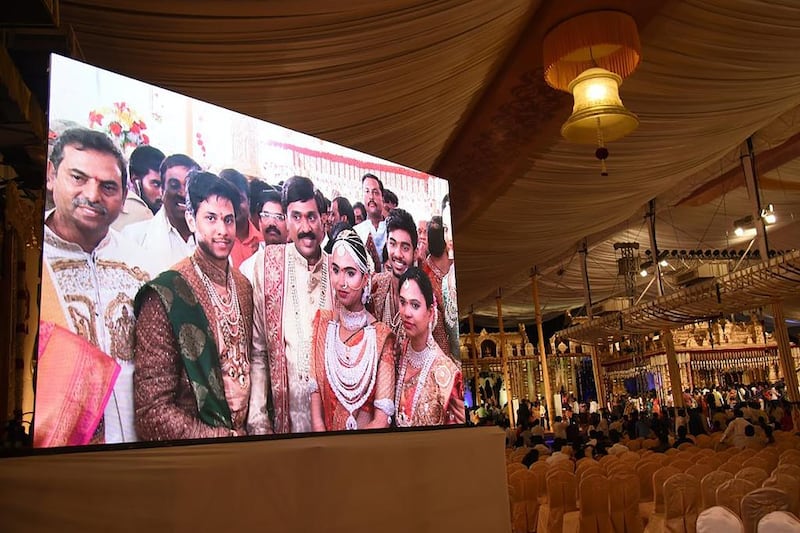NEW DELHI // When Indian lawmaker Ranjeet Ranjan attended a relative’s Punjabi wedding with her son three years ago, they were both struck by the opulence and extravagance of the affair.
Her son Sarthak, then 17, turned to her and said: “Mama, please don’t spend in this insane way when I get married, OK?”
Just last year, one of the employees in Mrs Ranjan’s constituency of Supaul in Bihar told her that he was going to have to spend 500,000 rupees (Dh27,500) to get his daughter married. His salary was a mere 10,000 rupees a month.
The two incidents set Mrs Ranjan thinking. The result was a private member’s bill which she plans to introduce in the next session of the lower parliament on March 9, limiting wedding expenses for all Indians to 500,000 rupees and limiting the number of guests.
If a family spends above this amount, it will have to donate 10 per cent of the surplus to a special fund which will go towards the marriage of girls from poor families.
"The root cause of most of our social evils is parents having to spend vast amounts of money on weddings and the dowry. We need to stop it urgently because the middle class, lower middle class and poor families – 90 per cent of our population – are suffering," Mrs Ranjan told The National.
“Weddings are meant to be celebrations, not obscene spectacles. For miles and miles, you have tables loaded with Thai, Chinese, Continental, Italian, Vietnamese and Indian food. People are so full after the starters that most of them leave. Think of all the food that’s wasted,” she said.
There is no denying that weddings have become extreme displays of wealth in India. Weddings are almost entirely the responsibility of the bride’s family and are used to display the family’s wealth and status. Families can spend decades paying off debts from weddings.
Even in rural India, poor families sell precious land or end up in debt for the rest of their lives in order to throw an elaborate wedding party for their daughter.
“It’s OK for the three per cent of Indians who want to burn their money on obnoxiously vulgar weddings but we need to think about the vast majority of Indians who are oppressed by this custom,” said Ranjana Kumari, head of the Centre for Social Research in New Delhi.
Weddings, and the accompanying dowry, are also why boys outnumber girls in India. Afraid of the money they will have to spend on their daughter’s wedding, many couples opt to abort a female foetus.
The practice of female foeticide has resulted in a skewed gender ratio of only 918 girls born to every 1,000 boys, according to government statistics for 2011.
India’s rich and the political class have set the standards of extravagance.
When mining baron and former minister Gali Janardhan Reddy’s daughter got married in December, he paid for an ancient kingdom to be replicated in the grounds of a palace in the south Indian state of Karnataka.
Bollywood stars performed for the 50,000 guests during the three-day celebration, while 3,000 security guards were deployed to ensure their safety.
The wedding cost five billion rupees with the bridal jewellery alone costing 900 million rupees.
In 2004, the northern state of Jammu & Kashmir was alarmed at how the rice and mutton used in wedding feasts – at least 30 dishes is a sine qua non of a Kashmiri wedding banquet – had caused food shortages.
The state government invoked a rule that same year to limit the bride and groom to 50 guests each, and laid down how many kilos of rice and meat could be used.
That rule was only temporary, however, and never became a law, which is what Mrs Ranjan is seeking with her Marriages (Compulsory Registration and Prevention of Wasteful Expenditure) Bill.
On Tuesday, the government in Jammu & Kashmir issued a fresh temporary rule to curb lavish weddings. This time though, it stipulated that the number of guests had to be limited to 500 on the bride’s side and 400 on the groom’s, while only seven main dishes and two desserts could be served.
“Young Indians support me. They tell me we have to change our mentality. Someone has to start but no one wants to make the first move,” said Mrs Ranjan.
Several editorials in the Indian media have pointed out that, if passed, the bill will destroy the wedding industry – worth about US$40 to $50 billion (Dh146.9bn – Dh183.6bn) and growing at about 25 to 30 per cent annually.
Critics say enforcing the 500,000 rupees ceiling will not only bring more government interference into private matters but will also be difficult to enforce.
Mrs Ranjan disagrees, pointing to how child marriages – once equally entrenched in Indian society – were eventually banned and hardly occur now.
“Once my bill becomes the law, I will be giving a powerful weapon to families,” she said.
foreign.desk@thenational.ae





